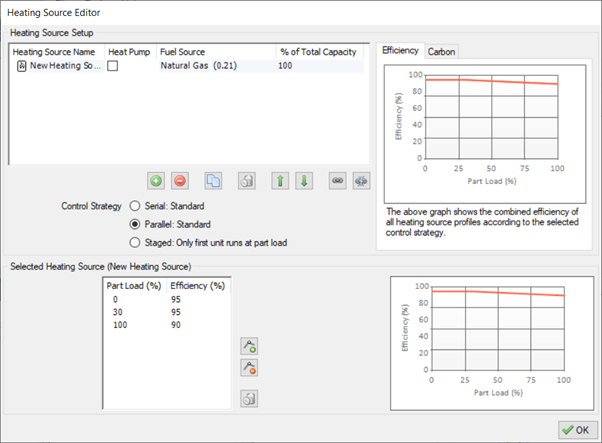Adding the Boiler Efficiency Details¶

Part load efficiencies can be modelled in Tas. Delete and add part load points as needed using the Delete Efficiency Point and Add Efficiency Point buttons located next to the table.
To model a seasonal efficiency instead of part load efficiencies you can either input the seasonal value for all part loads in the table or delete all but one efficiency point and then have just the one seasonal efficiency value set to 100%.
Tick the Heat Pump box to model a heat pump. You will need to input equivalent efficiencies by multiplying the COP of the heat pump by 100. For example, if your heat pump has a COP of 4.5 then you will type in “450”.
Multiple boilers with different fuel sources can be modelled in parallel or series. The % of Total Capacity column must sum to 100.
You can model more than one boiler and set the control strategy to what’s called “staged” where the first boiler will only run at part load. Staged boilers are similar to having them run in series except that the first boiler will only run at part load or not at all.
If the control strategy is staged and the demand is smaller than the second boiler’s capacity then the first boiler will run at part load.
If the demand increases to the capacity of the second boiler then the first boiler will turn off and the second boiler will come on at full load.
If demand increases again but is smaller than the sum of the second and third boilers’ capacities then the second boiler will run at full load and the first boiler will turn on again and run at part load.
If demand increases yet again so that it is now equal to the second and third boilers’ capacities then the second and third boilers will be on and the first boiler will turn off.
Exercise and Notes¶
Click on the boiler or the (…) next to the boiler profile box to open the Boiler Editor window.
In this example we will not be modelling a heat pump. Enter part load efficiencies at 0%, 30%, and 100% as per the above figure. The boiler is more efficient at part load (95% efficient) compared to when it is running at full capacity (90% efficient).